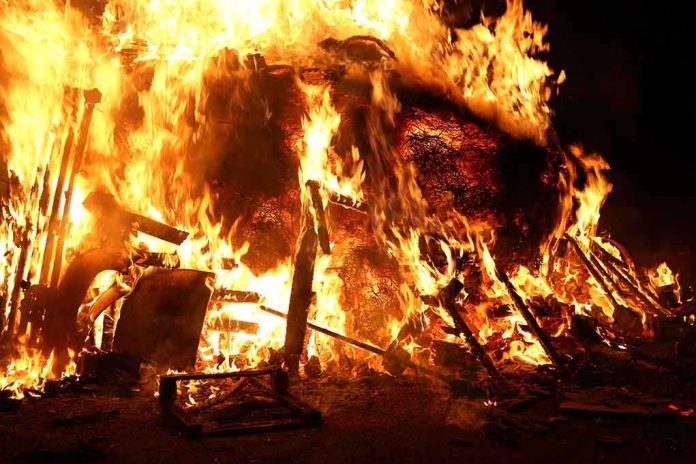
The historic Grand Canyon Lodge—an irreplaceable icon of American heritage—now lies in ashes after a wildfire rampaged across Arizona’s North Rim, underscoring how years of bureaucratic dithering and misplaced priorities can erase centuries of tradition in a matter of hours.
At a Glance
- The Dragon Bravo wildfire destroyed the nearly 100-year-old Grand Canyon Lodge, a National Historic Landmark.
- Fire exploded across 5,000 acres, erasing up to 80 structures and shutting down the North Rim for the 2025 season.
- Fire management choices by federal agencies face fierce criticism and political scrutiny from Arizona leaders.
- The loss devastates local tourism, jobs, and the cherished American legacy of Grand Canyon’s North Rim.
A National Landmark Reduced to Rubble: The Cost of Misguided Priorities
On July 13, 2025, as the Dragon Bravo wildfire surged under abnormal winds, flames consumed more than just ponderosa pines and park cabins. The Grand Canyon Lodge, standing since 1928 and rebuilt after a 1932 fire, became the latest casualty of what many see as a federal management system distracted by everything but the basics—protecting America’s heritage. The North Rim, always the quieter, less commercial sibling to the South Rim, drew generations of families looking for solitude and a slice of the old America. Now, with the lodge obliterated and the season canceled, visitors and locals alike are left mourning not just a building, but the vanishing sense of continuity and history that once defined the Grand Canyon experience.
Federal firefighting crews initially tried a “confine and contain” approach—waiting for nature’s barriers to do their job. But when fierce winds arrived, that strategy proved fatally flawed. With over 5,000 acres burned and no end in sight, the fire’s destruction extended far beyond the lodge: up to 80 structures were lost, and the threat to lives and property forced risky evacuations after chlorine gas leaked from a damaged water facility. This is what happens when federal agencies are more focused on environmental theory than real-world outcomes—leaving local economies, workers, and families to pay the price.
Finger-Pointing Erupts as Arizona Demands Answers
Arizona Governor Katie Hobbs wasted no time blasting the National Park Service and federal fire managers, demanding a full-scale, independent investigation into why “contain and confine” was the order of the day—especially during the hottest, driest stretch of the year. Senator Ruben Gallego echoed her outrage, calling the loss an “irreparable blow” to state history and demanding that someone take responsibility. The National Interagency Fire Center insists it’s doing everything possible, but the facts on the ground tell a different story: an iconic lodge, once bustling with tourists and workers, now reduced to blackened remains, while the region’s small businesses brace for a brutal year without the lifeblood of summer tourism.
This goes beyond just one park or one fire. The entire episode has reignited a national debate over the wisdom of “managed fire” policies—academic theories that sound great in grant proposals but collapse when real communities and irreplaceable landmarks are on the line. Once again, American taxpayers and families watch as their legacy goes up in smoke, while bureaucrats scramble to shift the blame.
A Blow to American Heritage and Rural Livelihoods
The destruction of the Grand Canyon Lodge is more than a headline—it’s a direct hit to the American story. Built with local stone and timber, the lodge was a testament to the grit and vision of an earlier America. Its loss erases a piece of national identity, one that cannot be replaced with any amount of restoration grants or government spin. For local families and businesses—already battered by years of pandemic restrictions and inflation fueled by reckless government spending—the North Rim’s closure is an economic gut punch. Jobs vanish overnight. Towns that depend on park visitors see their futures clouded by uncertainty and red tape.
On top of economic pain, there’s a deeper cultural wound. For generations, the lodge was a gathering place for families, a living monument to the country’s natural beauty and shared values. Now, as preservationists and historians mourn the loss, many are left asking: When will those in charge finally put American heritage and community well-being above bureaucracy and woke distractions?
What Happens Next: Scrutiny, Grief, and the Fight for Accountability
As the ashes settle, the push for answers is only beginning. Governor Hobbs and Senator Gallego are demanding that federal agencies face the music—no more hiding behind jargon and process. Park employees, concessionaires, and historians are joining the call for reforms that actually prioritize the protection of both natural and cultural treasures. The immediate focus is on containing the fire and safeguarding what little remains. But the broader fight is about ensuring that common sense, not ideology or inaction, drives the stewardship of America’s greatest places going forward.
For now, the North Rim stands empty—a stark reminder of what happens when those charged with caring for the nation’s legacy lose sight of what truly matters. The Grand Canyon Lodge may be gone, but the demand for accountability and restoration is just getting started. America deserves nothing less.
Sources:
Grand Canyon Lodge – National Park Service
Grand Canyon Rim-to-Rim History
Grand Canyon Lodge – Wikipedia
Grand Canyon North Lodge History










